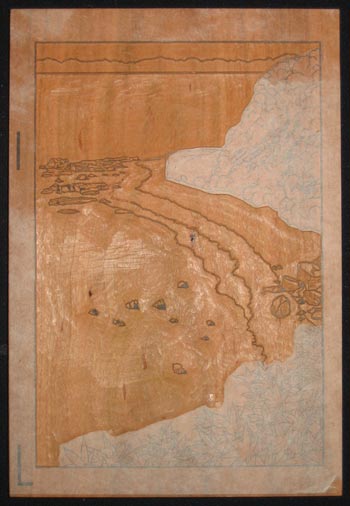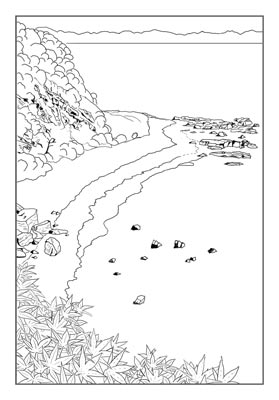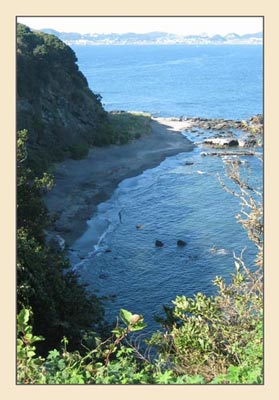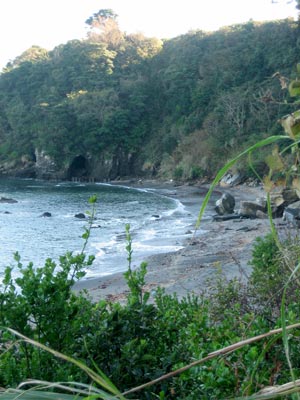Posted by Dave Bull at 8:18 PM, October 3, 2007
Continued from [Seacoast in Autumn - 2] | Starting point of the thread is [Seacoast in Autumn - 1]

I've had a couple of peaceful days of carving on the keyblock; here is a shot taken at the end of the first day:

It's moved along since then, and this block should probably be done this evening ... unless too much paperwork gets in the way again ...
After posting the image of the line drawing the other day, I got an email from friend Gary, who was wondering how I came up with the design, and whether or not I might have been studying his print designs quite closely. I was a bit confused by what he was on about, but after he sent me the link to a design of his, I realized that he must have been quite shocked when he saw mine!
Here's the line drawing I posted the other day, followed by his published image of Waimea Bay, on Oahu:


Woo-hee! I can see why he must have done a double-take when he saw my image! (I have to emphasize that he has made no accusation of plagiarism at all, just expressed interest in the design ...)
Honestly speaking, I hadn't studied his print at all, and although I have a familiarity with his work - of course, after publishing two of his prints - I certainly don't 'know' all his designs. So I guess I had better give a bit more information about the genesis of my own design. I mentioned in the previous post that I looked down on the beach from the cliff above - here's a photo I took from up there:

It seems that walking around on the cliffs of volcanic islands, looking down at the beaches below, will lead to some pretty similar landscapes!
I should emphasize that my print will not look very much like that photograph, which was taken late one afternoon, after the sun had gone off the beach. I've been back a number of times since that day, most recently to camp there and get some shots of the lighting at sunrise. Hopefully, I should be able to come up with something pleasing ...

The thread continues in [Seacoast in Autumn - 4] ...
Dave, absolutely no suggestion of plagiarism at all, I was simply amused at the coincidence of the vantage points we chose independent of each other. But then bays like this do not offer many angles that include most of the features of interest we'd like to show, so our options are limited. Good Luck in developing the print, I have no doubt it will surpass my primitive efforts of 'Waimea Bay'. Gary

bays like this do not offer many angles ...
Certainly not many angles that show all the 'components' of a scene like this: the beach, the sea, the cliffs, and the sky ...
But I am still quite a bit surprised just how closely our two images line up. I had originally intended to show my cove the other way around, from the north to the south - it's more 'photogenic' that way - but was unable to find a vantage point to get a photo. The cliffs are very dangerous, and without some support people, and things like safety ropes, there was just no way to get a clear shot. So I ended up using this alternate view, from the south.

Yes, getting the shots is often the most adventurous part of this kind of work, but that's what makes it fun. For Waimea Bay, I had to cross the river and drive up to an old Heiau where human sacrifices were made prior to European contact, that overlooked the bay, then hike into the brush following a muddy trail down to the edge of the ridge, where standing on tiptoes to get the view above the bushes, I could get the shot. During the hike it rained a bit, making the path quite slippery, and at one point my feet went out from under me. I had a black and blue butt for months to remind me of that adventure!

where human sacrifices were made ...
Nothing so romantic for my photo session, I'm afraid. I was standing in a radish field while taking that photograph! (The fields up there run right up to the edge of the cliffs, as the farmers try and squeeze out every square foot of space for growing stuff ...)

This looks like it's going to be a super print!!! - coincidentally I'm working on a coastal/cliff piece (sketched and photographed high up along the Dorset coast in the U.K.) - not nearly as dramatic but inspired somewhat by an exhibition of Hiroshige's 'Tokaido' series at a museum in Brittany this summer. I hope to be doing a series from both sides of the 'Manche' which will take years..... apologies for my ignorance but what is Gary's surname so I can see more of his prints as well?

Some of your photographs down on the beach show what looks like a cave with some old pier pylons in front by the water. Any idea what the history of this place is?

a cave with some old pier pylons in front...

As for the cave, it seems to be mostly natural; the cliff here is made of a kind of sandstone (in layers), and wears away very quickly in places where it is exposed to wave action. But it has also been expanded a bit I think, and I would guess that this may have been connected with the war. All over the area around this beach are left-over concrete structures which are almost certainly gun emplacements. This is the entrance to Tokyo Bay and they must have been preparing to defend it against sea invasion. I am sure that in the summer of '45 this wasn't a very lonely beach at all, but was crawling with activity!
As for the pylons, they don't seem to be part of a pier. That particular headland is the only one in the area that is blocked at high tide, as the others can all be navigated. These concrete pylons are placed in a row allowing people to 'walk' across the difficult section at high tide. Most of them have been washed away, and just the few you see in the photo still survive.








